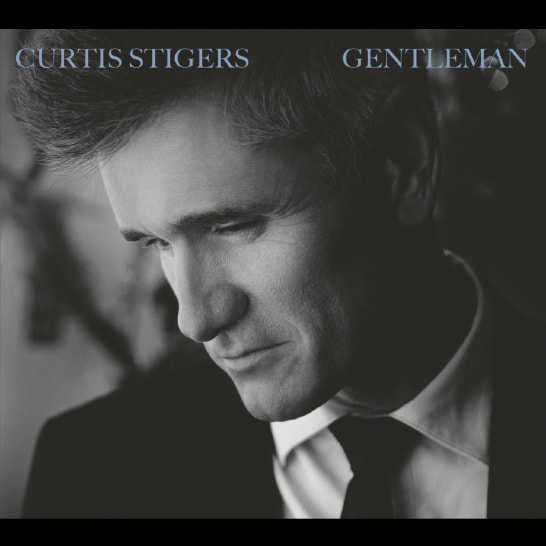 ';
view
';
view

Inspired marriage of visceral clout and intellectual savvy.”
—New York Times
I cannot think of another vocalist who creates such an exuberant combination of bebop artistry and raw emotion.”
—London Sunday Times
When Curtis Stigers came on stage on Wednesday night, it felt as if someone had upped the wattage in the bulbs.”
—Wall Street Journal
Curtis Stigers drives his publicists crazy.
For the past 30 years, the singer, songwriter, saxophonist and guitarist has been making records that confound those who try to categorize his music or put him in a box.
CURTIS STIGERS – Songs From My Kitchen, Volume 1
Curtis Stigers burst onto the recording scene in 1991 with his eponymously-titled debut album, which sold 1.5 million copies and spawned several self-penned, pop/soul hit singles, including “You’re All That Matters To Me”, “Never Saw A Miracle” and the worldwide top-ten hit, “I Wonder Why.” The next year the singer/songwriter/saxophonist recorded Nick Lowe’s “(What’s So Funny ‘Bout) Peace Love and Understanding” for “The Bodyguard” soundtrack, which has sold over 45 million copies worldwide. Stigers recorded two more pop-oriented albums in the 1990s and made guest appearances on several albums, including two by his early musical mentor, the legendary jazz pianist Gene Harris. In 2001 Stigers pivoted artistically and signed with Concord Jazz. Over the next 18 years he recorded nine genre-busting albums, combining his jazz sensibilities with his love for emotional, well-written modern songs from a wide variety of sources including rock, blues, soul, country and folk. During this period Stigers co-wrote and sang “This Life”, the Emmy Award-nominated theme song to the wildly popular TV show “Sons Of Anarchy”, and also made cameo appearances in the Seth MacFarlane movies “Ted” and “Ted 2”. All the while, Stigers was cultivating a successful and enduring touring career, playing concerts around the world, performing songs from his jazz albums as well as newly reconstructed “jazz” versions of his hit songs from his early pop albums.
Then 2020 and the Pandemic arrived, and with it a whole new artistic reality. Sidelined at home in Idaho with his wife and four very cute dogs, Stigers, in an attempt to continue to make music and stay in touch with his fans, created a weekly internet livestream show called “Songs From My Kitchen”. The show featured Stigers playing songs in his kitchen, surrounded by his dogs, who didn’t hesitate to whine or wrestle or bark during a performance, especially if the mailman showed up. The freedom of playing solo with only his voice and his guitar allowed Curtis to rediscover some of his older material, songs from his albums and songs previously unrecorded, all in an unplugged, impromptu setting. Additionally, he covered songs by other artists and writers he admired, just for the musical joy of it. It was also a chance for him to hone his acoustic guitar playing, a skill he’d previously used primarily as a tool for songwriting, not performing. “Being stuck at home allowed me the chance to challenge myself and to grow as an artist. I even taught myself how to edit video so I could make homemade clips for the show. It was one of the most creative periods of my life, that strange, isolated year and a half.”
The new Curtis Stigers album “Songs From My Kitchen, Volume 1” is a look back at that time and those more than fifty livestream shows, and also a look ahead to the current and future Curtis Stigers, singer/songwriter and connoiseur of great songs. This is his 14th studio album, and it’s a stripped-down, acoustic affair, with intimate performances of songs Stigers has written, rediscovered, or covered. “Some of the original songs are relatively new and some are many years old and only now getting a chance to be heard and sung. I like to think I curated this album as much as I created it.”
Stigers continues, “The process was organic and casual. I’d wake up in the morning, drink a cup of tea and choose a song to record – one of my own or one that I’d been thinking about and playing around the house. Then I’d drive a short mile down State Street to a little home studio my friend Don Cunningham built into his garage, and I’d record that song live multiple times, with just my acoustic guitar and my voice, until I had a version I could live with. I did that for a couple of weeks until I had enough songs to make up an album and then I brought in a handful of local musician friends of mine – Bernie Reilly on acoustic bass first, then Shaky Dave Manion on electric guitar, percussion by Casey Miller, and some electric piano by Professor Andrew Cortens. After that, I sent a few of the tracks to the singer/songwriter and multi-instrumentalist Jens Kuross to add some of his unique sonic touches. Whatever each track needed. Some ended up virtually solo acoustic and others sound like a full band. I liked not knowing where I was going until I got there. That improvisational, instinctual search has always been one of my favorite things about being a musician.”
About the title of the album Stigers says, “I called it ‘Volume 1” partly as an inside joke, and partly because there are still a lot of great songs out there, and in here, too. You never know.”
Here’s what Curtis Stigers has to say about the songs:
“’Until You Were Gone’ was written by one of my favorite singer/songwriters, John Fullbright. This is the second of his songs I have recorded. His song “She Knows” is a highlight of my 2020 album Gentleman. I’ve been playing ‘Until You Were Gone’ around the house for several years and I sang it several times on my livestream show. It’s a gorgeous song about the one who got away. I love Shaky Dave’s Manion’s soulful electric guitar playing on this.”
“I wrote ‘I Have Everything’ with the wonderfully offbeat, eccentric singer/songwriter and guitarist Billy Harvey. The song we wrote can be described as my life story in four simple verses.
Verse 1: Hopeful, uncynical, innocent, teenaged me.
Verse 2: Young adult me discovering my art and career in New York City, and meeting and falling in love with the mother of my child.
Verse 3: Mid-life me in the dark, solitary days at the end of a long, but ultimately broken, marriage.
Verse 4: The older, grateful me, realizing that there is life and love on the other side of heartbreak and disillusionment.
The message? No matter what, we have within ourselves EVERYTHING we need to survive, to live, grow and thrive, as long as we have patience, grace, gratitude and love.”
“I wrote ‘Burn It Down’ years ago with my brother Jake. We wrote the music together, and I wrote the lyrics based on a vivid memory of a childhood school trip to the Old Idaho Penitentiary. The terrifying details of the tour of that draconian sandstone-walled hell stayed with me over decades and fostered the seeds of a fictional but plausible story of a man stuck in the Kafkaesque nightmare of a broken and corrupt U.S. legal system. Jens Kuross created the spooky soundscape.”
“I must admit I’d forgotten about ‘Don’t Look At Me That Way’, the song I wrote with the fiercely unique singer/songwriter Brian Kennedy. I met Brian on the steps of Belfast City Hall in 1995 on the historic night when Bill Clinton famously lit the Christmas lights at the dawn of what eventually became the Good Friday Peace Accord. A Belfast-native, Kennedy sang with Van Morrison and his band that night, and I sang a song with my band. Some years later Brian and I got together in New York City to write, but I was preoccupied with the recent birth of my daughter and the launch of my jazz recording career, so I left it for him to record, which he did quite beautifully. Recently I bumped into Brian backstage at a show in Northern Ireland and he reminded me of that decades-old song of ours, and I fell in love with it. This song is so sad it even made my 20-something daughter cry when I played it for her. That’s an artistic victory in my book.”
“‘Old Fashioned’ is one of my favorite songs by California-born, Idaho-based singer/songwriter Bill Coffey, who happens to be my dear friend and across-the-street neighbor. When I sing it, suddenly it’s autobiographical, particularly in light of my early success in, and eventual disillusionment with, the pop record business. It also happens to refer to the cocktail I learned to make (and love) during lockdown.”
“I was born in October 1965 but I didn’t meet my biological father until the summer of 2012. It’s a long story best told over dinner and a bottle of red wine, but ‘Good To Know You’ is my musical reflection about gaining a father at midlife and learning how to navigate that relationship. Spoiler: It has a happy ending.”
“I’ve been singing Patty Griffin’s song ‘Goodbye’ for over two decades, at home and occasionally at a party or house concert. It’s always hit me hard and deep but I’ve never had the opportunity or reason to record it. I lost my mother in December 2023 and that suddenly changed. I sang this masterpiece of grief and healing at her memorial and I dedicate it to her every time I perform it.”
“During the lockdown, my friend, Idaho singer/songwriter James Coberly Smith, sent me the beginnings of the song ‘It Doesn’t Have To Be Now’ including much of the first verse and the title. From there I took liberties and turned it into something I think he was surprised by, but ultimately gave his blessing to, thankfully. It’s a dark love song about a pair of lovers who know their affair is wrong and ultimately doomed, but they keep putting off the inevitable because, well, love. That’s my dear old friend Catherine Merrick singing the harmonies.”
“In the autumn of 2019 I attended a concert at the legendary Boise music venue The Neurolux and discovered the genius of singer/songwriter Jeffrey Martin. He sang ‘Golden Thread’ that night and I fell in love with it. The bridge has become my daily mantra: ‘Teach me how to shut my mouth, Shut my mouth, Shut my mouth’”
“I was moved to write ‘The Song’ after reading the astonishing, epic novel ‘Cloud Cuckoo Land’, the most recent book by my friend, the Pulitzer Prize-winning author Anthony Doerr. Released in 2021, it’s a paean to the eternal power of storytelling and it inspired me to keep creating through some of my darker days late in the pandemic. I was proud to debut the song at a reading/lecture Tony gave in our mutual hometown, Boise.”
“I wrote ‘Lighten Up, It’s Christmas’ years ago, specifically to sing at an annual December fundraising concert I produce and host, which has raised millions of dollars for a local homeless shelter over the past 18 years. The song was (and remains) a reminder to myself to be grateful and graceful, even when this world is threatening to break my heart.”
Born in Hollywood, raised in Idaho and transplanted to Manhattan for sixteen years, Curtis Stigers now resides, between concert appearances, back in Boise, Idaho, where he’s proud to support Interfaith Sanctuary Homeless Shelter.



